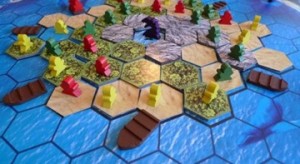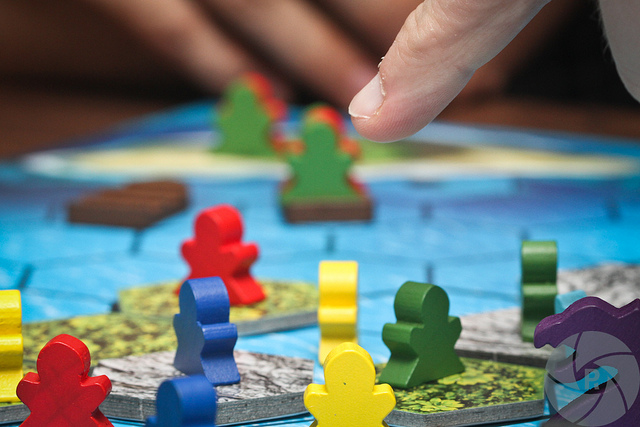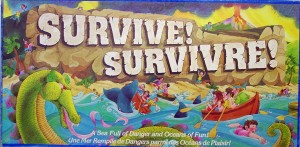Note: This review refers to the game Survive, aka Survive!
AKA Survivre!
AKA Escape From Atlantis*
AKA Survive: Escape from Atlantis!
*Sort of. But not really. Except yes. Mostly . . .oh just keep reading.
The Premise
A volcano is erupting on the island of Atlantis, dooming the land to a watery demise. Each player is in charge of a small tribe of inhabitants on the island, and it is up to everyone to get as many of their Atlanteans to the safety of neighboring islands before the island explodes and falls into the sea.
The Rules
Survive: Escape from Atlantis is a game aptly named, as survival really is the principle goal. Each player has a set of 10 inhabitants that they must rescue before time runs out. In the meantime, players also have to worry about the island sinking, sea critters looking to feed, and other players trying to do their folks in.
 To start the game, the island of Atlantis is randomly built by placing a series of Forest, Beach, and Mountain hex pieces.
To start the game, the island of Atlantis is randomly built by placing a series of Forest, Beach, and Mountain hex pieces.
The starting player is determined randomly. Then, players take turns selecting and placing one of their ten people on various tiles. On the bottom of each figure is a number from one to six, indicating that unit’s value. Players are only allowed to look at these numbers during this placement phase – once the game begins, players will have to remember which meeple is which. Once all units are placed, each player repeats the process by placing two life boats along a shore tile. Finally, players pray to Poseidon, and the game begins.
Each player follows the same turn structure: First, they may play a tile from their hand. Next, they move any number of people and/or boats a up to a total of three space. Then, they flip over and remove an island piece from the board.
When flipping an island tile over, players must choose them in sequence: first Beach tiles, then Forests, and lastly Mountains. When players do this, the tiles will either have an immediate effect (i.e. place a Shark in the water), or the player will be able to retain them in their hand for use in subsequent turns.
Lastly, the player rolls the Creature die to determine which, if any, creature moves. The game begins with five Sea serpents swimming around, but other creatures will be added throughout the course of the game.
The game ends when one of the Mountain tiles flips to reveal the volcano. At this point, the island explodes. The ensuing tidal wave wipes out any units not yet on the outlying islands. Players count up the value of their safely rescued pieces, and player with the highest number is the winner. They can rejoice that their Atlanteans will go on to become the ancient Olmecs, Egyptians and Narnians. Or so the stories say…
A Whale, a Shark, and a Sea Serpent Walk Into a Bar…
…they proceed to eat and destroy everything. Cue credits, and we are out of here!
What’s left in their wake is a game that, at first glance, can come across as a typical Ameritrash game: it has limited strategy, it isn’t terribly complicated, it’s high on luck, and it’s low on most gamers’ radars.
And, admittedly, it may not keep the attention of hardcore Architects or Tacticians since the tone of the game is of destruction rather than creation. Survive very much focuses on a turn-by-turn approach, and that usually isn’t enough for these groups. Moreover, while its theme is a bit timeless, and there is plenty of flavor to reinforce the idea, there likely still won’t be enough material for your Immersionists to attach themselves to it. Indeed, the original version was simply a nameless island; the name Atlantis was tacked on in the subsequent reprints.

You have been marked for death.
A poor game though, it is not. Survive is from the era of game design that game after the classic games we know today, but before modern game design took hold, and the fact that it still resonates with players is a sign of its value. There is enough going on to keep Socializers and younger players engaged, although it should be noted that you don’t often play nice with one another.
Between well-timed use of hex tiles and where (or whom) you decide to direct the sea creatures on each round, Survive can be a bit more cutthroat than some may expect in a family-style game. Because of that, though, there is just enough capability to mess with other players directly that should keep Strikers content, though they may not run out and buy a copy for themselves.
Moreover, Survive can be quite unpredictable. There is certainly enough chaos (the island is sinking, after all, and the waters are full of beasties) to keep those lovable Daredevils happy. The game is straightforward in that most players will only have to reference the rules to decipher what the different tiles mean, letting players focus more on the in-game interaction.
The game’s elegance is in its simplicity, and Survive! should be judged more on what it offers than what it could be lacking. Survive! doesn’t pretend to be anything beyond what it is: a short, entertaining scenario about surviving the fall of a civilization.
What’s in a Name?

Bilingual devastation for all
As alluded to earlier: the game Escape from Atlantis is – and is not – Survive: Escape from Atlantis! The game mentioned here is the 1982 game Survive! by Parker Brothers. A second, nearly-identical game was crafted for Waddingtons Games in 1986 called Escape from Atlantis.
The three main differences were:
- They included the use of dolphins in the game that, unlike the other three sea creature types (whales, sharks, and sea monsters), actually help you.
- The movement of the sea creatures could be much more unpredictable and wide-ranging.
- Each of the three hex types were of different heights physically as to give a 3-dimensional representation to the island.
This shouldn’t be a surprise, as both games were made by the same person. When Stronghold Games decided to bring the game back into print in 2011, they made a clever move – they merged both versions into one box. In addition to upping production values of the pieces, they kept the entirety of the Survive! edition but introduced the tiered hex idea into the base game, which was a nice touch. Moreover, they also provided the dolphin pieces and the additional monster dice necessary to play Escape from Atlantis, which is listed in the game variant section of the rules as ‘Challenge Rule 5’. This both eliminates the need to worry about two editions and provides additional replay options should you not find the original game brutal enough. Well played, Stronghold Games.
The Takeaway
Survive is solidly in that camp of Gateway Games. There is some light strategy and player vs. player aggression, but most of what happens relies on luck. The simple rules paired with that element of chance makes for a decent alternative to more common games for new players. Granted, the sinking island theme is borderline cliché these days, but this is a classic example of it being used successfully. It sounds odd, but Survive is a light game about a major disaster. And it works. Now on its 30th anniversary since release, players should consider picking this up whenever if they are looking for a fun family game or attempting to expand someone’s gaming horizons without having to endure an hour and a half of Wood for Sheep jokes.
Survive! is a product of Stronghold Games.
![]()
Cardboard Republic Snapshot Scoring (Based on scale of 5):
Artwork: 3
Rules Clarity: 4
Replay Value: 4
Physical Quality 3.5
Overall Score: 3.5

